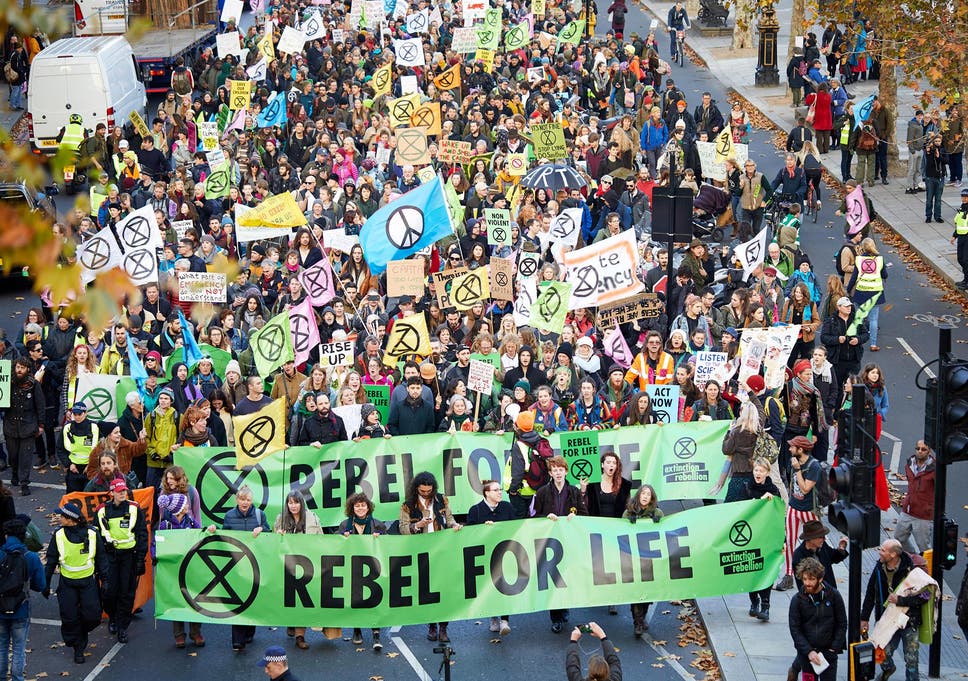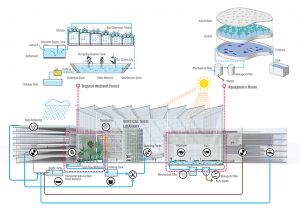The related extinction and climate crises that are threatening the survival of life on earth can only be solved by reducing our ecological footprint – systematically curbing impacts and repairing nature to a level that sustains us within the planet's means.
“We are facing a
climate catastrophe.” These are not just the words of tree-hugging
Gaia-worshippers. They were said this week by the Legal
& General insurance company, the UK's
largest money manager, which last year blacklisted many companies for
being unsustainable.
"As financial
policymakers and prudential supervisors we cannot ignore the obvious
physical risks before our eyes. Climate change is a global problem,"
they said in a statement.
Mark Carney, the
governor of the Bank of England, and Villeroy de Galhau, the governor
of the Banque de France, said the same in an article
in the UK Guardian newspaper this week, as they
called upon financial institutions everywhere “to raise the bar to
address... climate-related risks and to “green” the financial
system”.
The wave of protests
sweeping around cities across the world – International
Extinction Rebellion – is simply asking for
common sense to prevail in the face of the overwhelming threats
facing the planet.
The plain fact is that all money spent everywhere must now be only spent sustainably: to meet our needs while also rebuilding & repairing our planet.
Not unlike the immediate French and worldwide response to the devastation of Notre Dame Cathedral, we must all, especially our leaders, pledge to take urgent action. Watching this global icon go up in flames has struck the hearts and souls of people around the world; within a few days almost €1 billion have been pledged to rebuild it.
Rebecca Johnson, a
former Greenham Common anti-nuclear protestor
compared this to the extinction crisis on BBC News:
"Imagine millions of Notre Dames, all over the world, and not
just art and history, but full of people, animals, plants and
insects, the biodiversity. That is what the protesters are concerned
that leaders are doing nothing about."
The movement's
articulate young visionary, Greta Thunberg, told
an assembly of European members of parliament this week:
"We need cathedral-like thinking".
Watch this speech. She
cries as she laments the rate of extinction of species. "Forget
Brexit, tackle climate change," she tells the MEPs, to a
standing ovation. “Our house is falling apart and our leaders need
to start acting accordingly and they are not.”
As she was speaking,
and all this week, the streets of European cities are being blocked
by Extinction Rebellion protesters, who have pledged not to stop
blocking traffic until their demands are met.
Some city leaders are already responding.
About 100 cities and towns in the UK have already passed resolutions declaring a climate emergency.
The website
climatemobilisation.org
is attempting to keep track of all cities in Switzerland, North
America, Australia and the UK which have done so and has so far
logged about 460 of them, including 18 in Australia, such as Darebin,
Yarra, Vincent, Victoria, Gawler, Mariby, Hawkesbury and Adelaide
Hills.
In California, Los
Angeles, Berkeley, Richmond, Oakland and Santa Cruz have also done
this, to name but a few.
The question for everybody, is what does a council do to follow up, having passed the resolution?
To meet the demands of the resolution they have to become carbon neutral by 2030 at the latest. They also have to include the population in their decision-making.
This will necessitate
action on many fronts.
There is a solution.
All towns, regions and cities must become 'one planet'.
A campaign is beginning to persuade cities, towns and communities to declare “one planet" status that allows them to plan and track a path into the “safe and just space” defined by the work of Kate Raworth and others, where the basic needs of citizens are met without damaging the planet.
The
framework proposed is a way for any town and
city to work out how to #MoveTheDate
of their Earth
Overshoot Day (a measure of unsustainability)
to become more and more sustainable over time using a framework
like this.
I am beginning in my
own part of the world with #OnePlanetSwansea, #OnePlanetCarmarthen
and #OnePlanetLlandeilo. Work is underway to tackle Cardiff, the
capital of Wales.
You can start this
process in your own town, wherever you live.
The aim is to make all
cities regenerative, based on circular economies and renewable
energy, to ensure we live within our means. The solutions already
exist. Policies to support them must be based on evidence, not upon
ideology, belief systems or loyalties, because we are all in this
together.
Policymaking has not
caught up with the fact that humanity crossed the threshold of “one
planet” living and began living in deficit way back at the
beginning of the 1970s. This is why we need data, indicators and a
coherent plan to relate our activities to what the biosphere of our
planet can tolerate.
The six-step path towards One Planet Cities and communities
- Obtain community buy-in and feedback at all levels
Hold a series of public meetings and online and
off-line consultations to explain the context and aims in order to
obtain feedback and community buy-in.
- Decide which standards and objectives to use
These will include a methodology and accounting
system and be applicable to all sectors such as soils, biodiversity,
water, energy, buildings, transport, well-being, etc. They must
include ecological footprinting.
- Set baseline – the current situation
Use data and surveys to ascertain the starting
point from which goals will be set: On the supply side, the
productivity of its ecological biocapacity
(greenspace and water bodies). On the demand side, the ecological
footprint – assets/resources required to
produce the natural resources and services it consumes.
- Set targets for each sector over realistic timescales
A system similar to that applied by the UK Climate
Change Act could be adopted, along with the Global Footprint
Network’s Net
Present Value Plus (NPV+) tool to test the
results of different scenarios. A set of five year plans may result,
each with a budget and a set of targets. The overall target could be,
say, 30-40 years away, to meet everybody’s basic needs within
planetary limits. Each short-term target will be a step closer to the
overall one. Each sector (biocapacity, water, food, energy,
buildings, transport, industry, etc.) will have its own schedule.
- Set in place ways to measure them
This should be based on what data is easy and
cost-effective to gather, and relate to the baseline situation,
chosen metrics and sector targets. The data should be transparent and
publicly available. Everybody should be able to view the progress
being made.
- Ratchet down consumption over one or two generations.
Each five-year plan will have its own evaluation
period to check that all expected benefits are resulting, to share
experiences, to accommodate criticisms, to potentially revise plans,
and to celebrate successes.
If a population’s ecological footprint exceeds the region’s biocapacity, that region runs an ecological deficit.
...which almost all regions now do. A region in ecological deficit meets demand by importing, liquidating its own ecological assets (such as overfishing), and/or emitting carbon dioxide into the atmosphere. It must therefore identify the origins, destinations and impacts of consumption.
It would then be
possible to model the effects of changes of policy and practice
towards a circular economy upon the related biocapacity.
Tracking the Human
Development Index (a measure of how human needs
are being satisfied) against the ecological footprint over a time
period can indicate the direction of progress.
Government agencies at
all levels can manage their capital investments in a fiscally
responsible and environmentally sustainable way by using ecological
footprint accounting and the Global Footprint Network’s Net
Present Value Plus (NPV+) tool.
The traditional net
present value (NPV) formula used by economists
adds up revenue and expenditures over a period of time and discounts
those cash flows by the cost of money (an interest rate), revealing
the lifetime value of an investment in present terms.
GFN’s NPV+ tool adds
to this calculation currently unpriced factors, such as the cost of
environmental degradation, and benefits like ecological resiliency.
All costs and benefits – even those where no monetary exchange occurs – thereby can be seen as “cash flows”, and can be evaluated using different future scenarios.
This will provide a more accurate and useful guidance on the long-term value of the investment, because it makes reference to the ecological footprint of the project in question.
The ecological
footprint can therefore help to identify which issues need to be
addressed most urgently to generate political will and guide policy
action. It can improve understanding of the problems, enable
comparisons across regions and raise stakeholder awareness.
By identifying footprint “hot-spots”, policymakers can prioritise policies and actions, often in the context of a broader sustainability policy.
Footprint time trends and projections can be used to monitor the short- and longterm effectiveness of policies.
By understanding where
the best long-term value is, policies can be oriented toward better
outcomes, building wealth, avoiding stranded assets and leaving a
better legacy for future generations.
The standard PAS
2070 can assist with monitoring cities’
carbon footprints of consumption and production. ISO
standards cover environmental management,
energy management and life-cycle analysis to help put in place
procedures for reducing impacts.
At the same time, all
citizens and politicians need to do more to raise awareness about the
issues.
More information at
http://theoneplanetlife.com/
If you want support in
doing this in your neighbourhood, get
in touch.
We can do this. It just
needs a massive, concerted effort.
David
Thorpe is the author of the book
The
'One Planet' Life
and the forthcoming book 'One
Planet' Cities.
















 Next year Bristol is to be
Next year Bristol is to be




